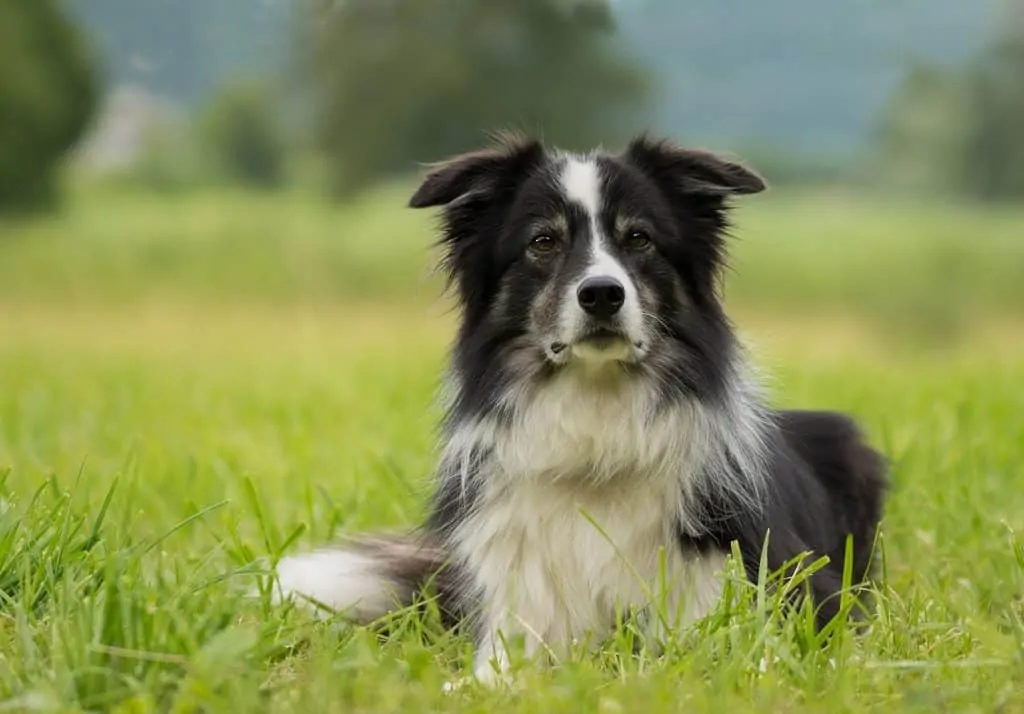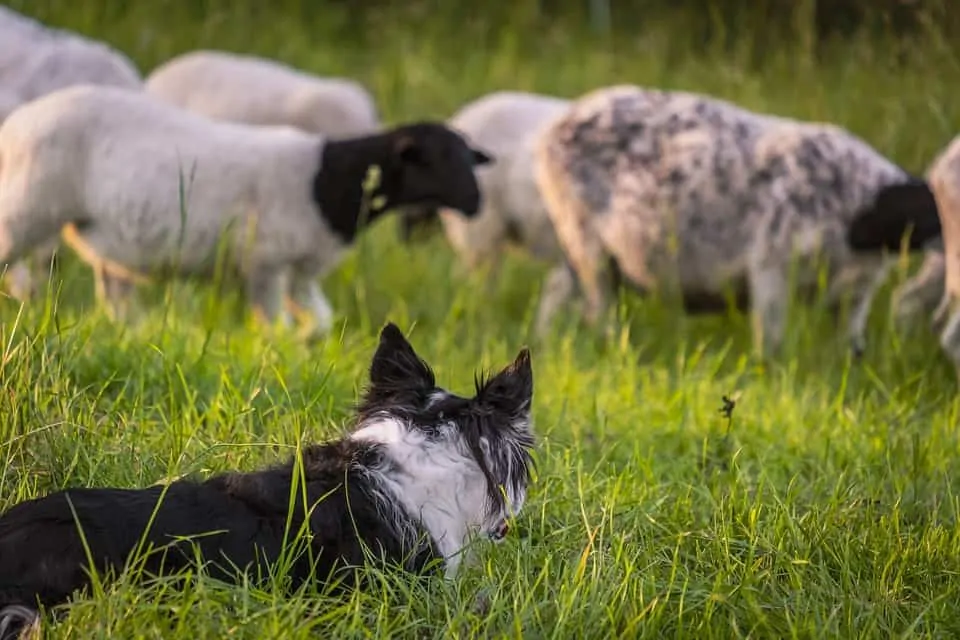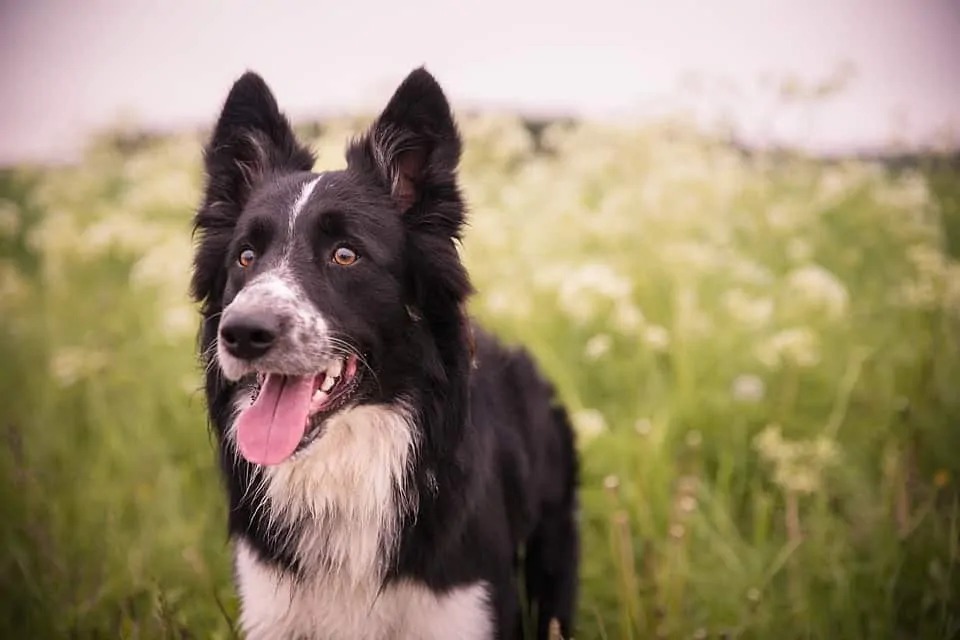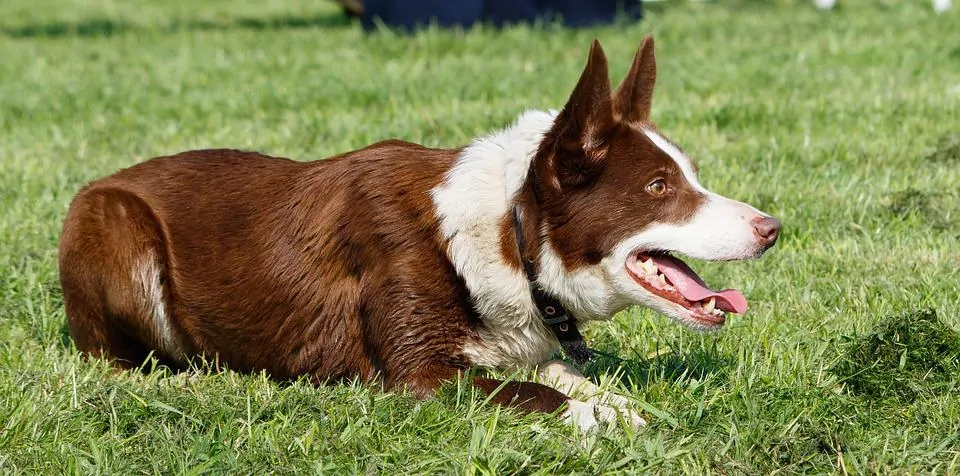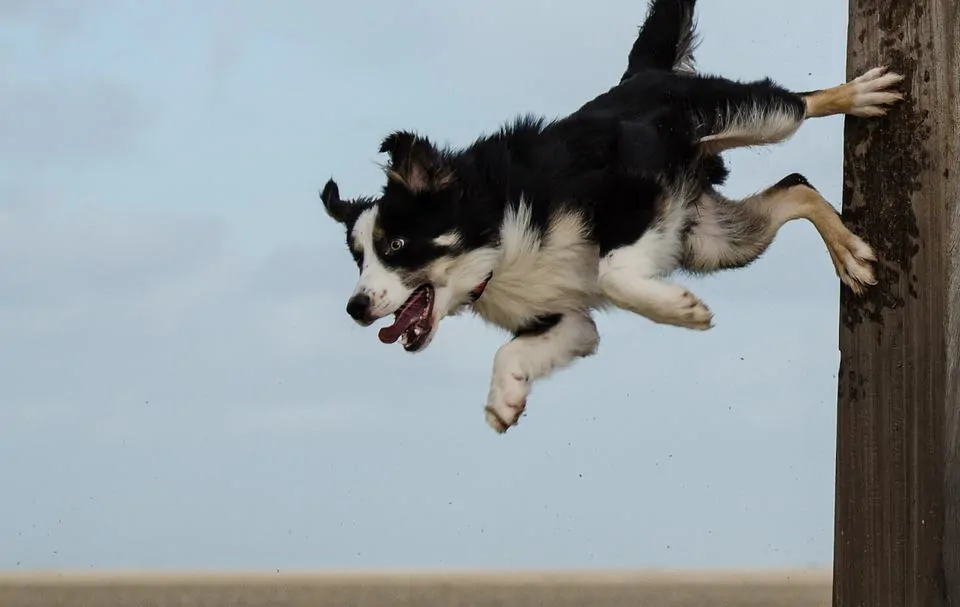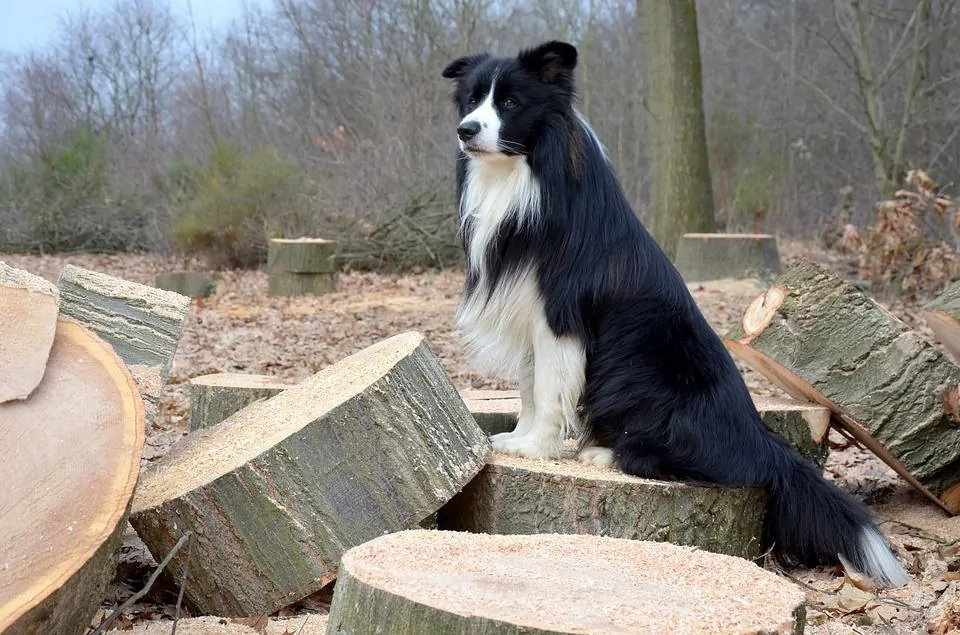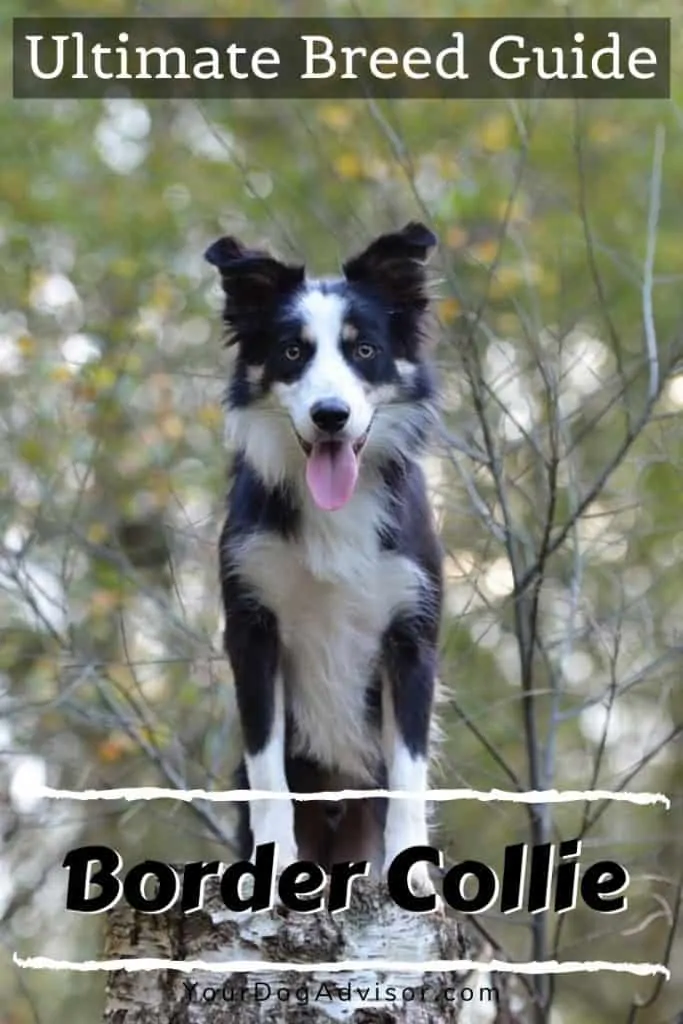The border collie is the doggy equivalent of both Einstein and an unflappable blue-collar worker. These highly intelligent dogs live to work and have enough energy to do so for hours on end. While their affectionate and loyal demeanor makes them one of the most highly sought after breeds, their intense, endless energy make them more difficult to keep than many realize.
Keep reading to find out if you have what it takes to bring this shepherd of boundless energy into your home.
Contents
General Characteristics of the Border Collie
- Other names: Scottish sheepdog
- Height: 18 to 22 inches
- Weight: 30 to 55 pounds
- Lifespan: 12 to 15 years
- Origin: Anglo-Scottish border
- Colors: Any, but most commonly black and white
- Activity level: High
- Grooming needs: Low
- Best suited for: Very active families, ranchers, and dog sport aficionados
The History of the Border Collie
To get a true sense of the history of the border, you need to go all the way back to first century Britain. While traditionally void of livestock, the invasion of the Roman empire brought with it cattle and sheep, and, more importantly, herding dogs.
These Roman shepherds likely descended from dogs common to the empire–namely large molossus types and fierce livestock guardians. This combination led to a dog that was quite thick-boned and much larger than many shepherds used today.
While quite useful back in their homeland, these big shepherds had difficulty working the rocky, hilly countrysides of Scotland and Whales.
Once the Roman Empire began to fall in the fourth century, new invaders swarmed to the area, including the Vikings. With them came smaller, spitz-type herding dogs that were best suited to the harsh, rocky terrain of Scandinavia.
The BC is the picture of poise and focus. Their keen expression and hard stare not only has the power to move the flock, but to move many owners to obsession.
Over the next millennia, these two vastly different types of shepherds interbred, creating a mid-sized shepherd with the stamina of the Roman herders but the athleticism to work smoothly over difficult terrain.
While these new herders looked more like the working shepherds most of us are familiar with, the border collie was still centuries from existence.
At the end of the 19th century in Northumberland, a county on the border of England and Scotland, landrace collies of various types were frequently used to assist shepherds in the fields. In 1893, a puppy named Old Hemp was born to two of these local collies.
While most shepherds of the day moved sheep using their bark and aggressive actions, Old Hemp worked in near silence and was able to move the flock almost without effort. His instinct and intelligence were so great, in fact, that it is said that he needed no training at all to learn to herd.
Old Hemp quickly gained notoriety in the area and it wasn’t long before other collie’s with similar herding behaviors were being bred to him to create a truly unique shepherd.
In 1915, the International Sheepdog Society first used the term “border collie” to describe this quiet, agile herder.
Today, the hyper-intelligent, instinct-driven BC is still commonly used on ranches, though they have become even more popular as companion animals.
The Temperament of the Border Collie
The unique herding methods of this shepherd also show through in their temperaments. Where the typical shepherd is loud, in-your-face, and “flighty,” the BC is quiet, observant, and ever-focused on their handlers’ next command.
They tend to be very affectionate and gentle dogs and are incredibly loyal, especially to their favorite person in the family.
Companion or show dog, the BC will always be a herder at heart. That means any prospective owner should have a good understanding of common behaviors seen in shepherds and how to appropriately redirect them when they are not desired.
While not as prone to nipping as other shepherds, their instinct to chase and herd is still very strong and can lead to issues if training and consistency isn’t used. Luckily, training a BC is rarely a difficult task. These dogs love to learn and are highly motivated to please, but even more motivated by their own need to accomplish a task.
Outside of intelligence and herding instinct, what most defines a BC is their high-energy level. These dogs were built to spend the day sprinting miles over rocky, hilly terrain. In the home, this energy often comes out in the form of undesirable behaviors like chewing, destroying furniture, and obsessive behaviors.
To keep your BC from turning to these less desirable energy outlets, you must provide plenty of physical and mental stimulation. A long walk around the neighborhood won’t cut it with these dogs. They need to work their brain as well as their body for hours each day.
Overall, the BC is an energetic and smart breed that needs a job to do before they can settle down with the family at night.
Health Issues Common to the Border Collie Breed
While overall a robust and hardy breed, there are a number of health issues known to affect the BC. Many of these are common to the collie line while others are specific to this unique dog.
Here are some of the more common health issues seen in border collies:
- Collie eye anomaly, progressive retinal atrophy, and glaucoma
- Epilepsy
- Hip and elbow dysplasia
- Neuronal ceroid lipofuscinosis
- Trapped neutrophil syndrome
- Hypothyroidism
One unique health issue that some BCs face is something known as “border collie collapse.”
During such an episode, an affected BC will suddenly become disoriented, lose attention for the task at hand, and may lose mobility in their hind end. Eventually, the dog will need to sit or lie down until they calm down enough for the episode to pass.
Because they were bred for function over form, there are a lot of variations in the look of a BC. While most have half-drop ears, some have fully erect ears, like this one pictured above, and others have full-drop ears like that of a retriever.
What causes this issue is unknown, but it is thought that these episodes only occur when an especially high degree of arousal is met. For most dogs, there is only one or only certain types of activities that cause collapse. Some dogs are unable to play with balls or herd because of this condition, but can still run, swim, and do other physically demanding activities without an issue.
Scientists are currently working to determine exactly what causes this issue in herding breeds and other high-drive dogs like labradors.
While there is still a lot of mystery surrounding it, it is worth noting that descriptions of Old Hemp, the “father” of the modern border, often described him working so intensely that he would visibly shake. This fact has many in the BC community wondering if this genetic anomaly has been present in the BC line since its very conception.
To avoid issues such as border collie collapse, collie eye anomaly, and other issues common in the breed, it is important to only purchase puppies from a credible, ethical breeder. Or better yet, adopt a BC with a well established health history.
Do Border Collies Do Well With Children and Other Pets?
Their energetic and affectionate nature makes the BC a favorite playmate for kids, so long as the child is old enough to play safely with a herding breed.
Because these dogs will chase things that run, small children and BCs don’t typically mix. The child needs to be old enough to use commands to keep the dog from nipping or getting overly excited or at least old enough to know to stop when the dog starts chasing them.
Like with ear type, coat length and coat color are highly variable in these dogs. Smooth coated BCs, like the one above, are less common than rough coated versions. These dogs can come in any color from solid to merel, but are most commonly black with white markings.
For older children and teenagers, the BC can be a great companion, especially if they have an interest in obedience or dog sports.
Typically, BCs do well with other dogs. Working dogs often work alongside other shepherds in order to cover more ground and work larger flocks, so being sociable has long been a desired trait in the breed.
While they do not always “play” the way most dogs do, BCs do enjoy chasing other dogs. BCs, like other shepherds, especially love to run fences, both at home and at doggy daycare.
So long as they are introduced to other pets, such as cats, early on in their lives, most BCs do well with non-dog siblings. If not taught how to interact with other animals as puppies, a BC may become overly interested and end up chasing smaller pets.
What to Consider Before Bringing Home a Border Collie
Think the Einstein of the doggy world is the right pet for you? Here are a few more things to consider before bringing a border home.
Activity Level
Wearing out your BC physically is a challenge. These guys are known for their stamina. And even when they are tired, their drive will keep them going for hours more. Jogging and running alongside a bike are great activities when you are short on time, but running off-leash in an open field or hiking through the mountains provide even more valuable energy releases.
Are you ready for this ball of energy? Keeping an intelligent dog means constantly having to find new ways to stimulate them mentally. Training high flying acrobatics and other physical behaviors is a great way to wear them out.
But the real challenge with this breed is tiring them out mentally. These dogs truly need a job to do. If you get a BC, plan to spend a small fortune on puzzle toys, trick training books, and doggy daycare. Or, better yet, sign them up for a doggy sport like agility, flyball, or freestyle dog dancing. If you live in a more rural area, you may even be able to find a dog ranch that specializes in letting companion herding dogs practice their original purpose.
Trainability
To say a border is trainable is an understatement. These dogs love learning and yearn for any opportunity to perform new, complex behaviors. Working borders must learn to differentiate and respond to dozens of different whistles and commands. This ability to learn so many behaviors and words is something unique to this breed.
Most BCs are more interested in chasing something than getting a treat, so, often, using a fetch toy as a reward produces faster behaviors than treat training. These intelligent dogs do not react well to harsh punishment and, given their intelligence, this training tact is rarely necessary. The most important thing in training a BC is consistency.
Grooming
BCs come in a variety of coat types from short “smooth” coats to longer “rough” coats but the majority of BCs have a medium-length double coat. In any case, this dog doesn’t typically require much grooming. A weekly brushing should suffice to keep their fur in good condition, though more frequent brushing may be needed during the twice-yearly shedding seasons.
As with all dogs, they do require daily teeth brushing and frequent nail trims.
Elegant and graceful, both in the pasture and in the flesh, it is no wonder so many have fallen in love with this loyal and beautiful breed.
Nutrition
The border is an “easy keeper” and will do well on any high-quality commercial or homemade dog food. Working dogs or competitive athletes will benefit from a higher protein, higher fat diet. Although not typical, some BCs will struggle with weight gain, so watch portions and waistlines closely.
Cost
BC pups are fairly common, especially in rural areas. A purebred will cost you anywhere from $700 to $2,000 depending on the breed lines. Because these dogs are more difficult to keep, there are also a decent number of pure and mix breed BCs available for adoption at any given time. Check with your local BC rescue for adoptable dogs.
10 Fun Facts About the Border Collie
- It is noted that scars in show rules, broken teeth, and other hazards of the working dog should not be counted against a BC in the show ring.
- The BC ranks number one in Stanley Coren’s The Intelligence of Dogs.
- Almost every border can trace their lineage back to a single dog named Old Hemp who showed unique behaviors when herding that differentiated him from other shepherds of the time.
- Between 1905 and 1951, every border who won the International Sheepdog Society’s championship was a direct descendant of Old Hemp.
- There are two different standards for working BCs and show BCs and few dogs compete in both types of competitions.
While not well known for loving water, most BCs will willingly chase a flying ball or flock of ducks just about anywhere. This drive can get them into trouble, so a reliable recall or stop command is much needed with these pups.
- The BC was not recognized by the AKC until 1995, due largely to the fact that BC breed clubs did not want the breed to compete in the show ring.
- Some agility competitions include “ABC” classes–“anything but collies”–because BCs are so skilled at winning these types of events that it makes it hard for anyone else to compete.
- “Collie” is the Scottish term for shepherd and likely comes from the Celtic term for “useful.”
- Chaser, a white and black border, was well known as the smartest dog in the world. She knew over 1,000 names for objects and could retrieve each of them when given the command.
- BCs are especially common in Australia where the harsh desert environment requires a hard worker who can cover a lot of land in a single outing.
Before You Go
Not sure you have the energy to keep up with this hard-working shepherd? Here are a few more breeds to consider.

Jen Jones is a professional dog trainer and behavior specialist with more than 25 years of experience. As the founder of ‘Your Dog Advisor’ and the ‘Canine Connection’ rehabilitation center, she applies a holistic, empathetic approach, aiming to address root causes rather than merely treating symptoms.
Well known for her intuitive and compassionate approach, Jen adopts scientifically-proven, reward-based methods, encouraging positive reinforcement over punishment. Jen specializes in obedience training, behavior modification, and puppy socialization. Her innovative methods, particularly in addressing anxiety and aggression issues, have been widely recognized. Jen has worked with many of the world’s leading dog behaviorists and in her free time volunteers with local animal shelters and rescue groups.
